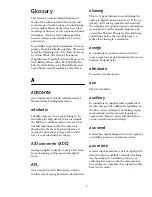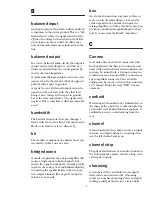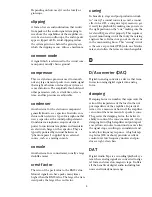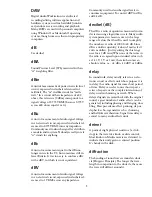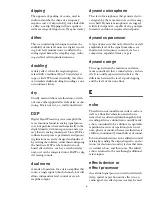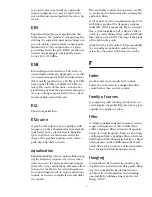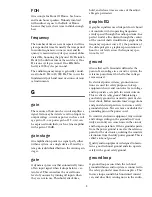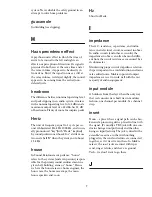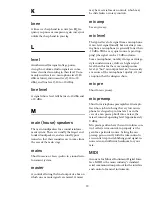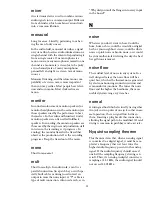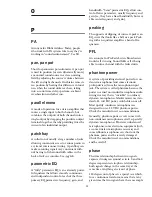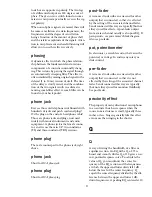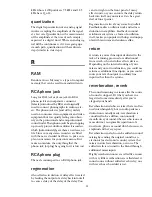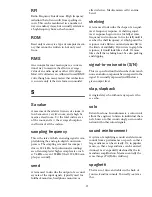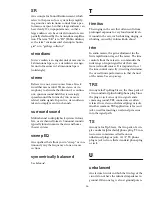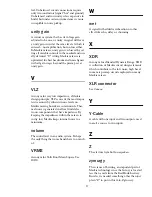
5
DAW
Digital Audio Workstation is a dedicated
recording/editing software application and
hardware system, used for hard disk (non-lin-
ear) random access recording and playback.
Many DAWs are used with personal computers
using Windows® or Macintosh® operating
systems, though some use their own proprietary
computers.
dB
See decibel.
dBA
Sound Pressure Level (SPL) measured with an
"A" weighting filter.
dBm
A unit of measurement of power in an electrical
circuit, expressed in decibels referenced to 1
milliwatt. The “m” in dBm stands for “milli-
watt.” In a circuit with an impedance of 600
ohms, this reference (0 dBm) corresponds to a
signal voltage of 0.775 VRMS (because 0.775 V
across 600 ohms equals 1 mw).
dBu
A unit of measurement of audio signal voltage
in an electrical circuit, expressed in decibels ref-
erenced to 0.775 VRMS into any impedance.
Commonly used to describe signal levels within
a modern audio system. Nobody is really sure if
“u” stands for anything.
dBv
A unit of measurement equal to the dBu no
longer in use in the US, but sometimes still in
Great Britain. It was too easy to confuse a dBv
with a dBV, to which it is not equivalent.
dBV
A unit of measurement of audio signal voltage
in an electrical circuit, expressed in decibels ref-
erenced to 1 VRMS across any impedance.
Commonly used to describe signal levels in
consumer equipment. To convert dBV to dBu,
add 2.2 dB.
decibel (dB)
The dB is a ratio of quantities measured in sim-
ilar terms using a logarithmic scale. Many audio
system parameters measure over such a large
range of values that the dB is used to simplify
the numbers. A ratio of 1000:1=60 dB. Since
dB is a unitless quantity, it doesn’t matter if it’s
volts or dollars. (just try asking the chief engi-
neer for a 3 dB raise) When one of the terms in
the ratio is an agreed upon standard value such
as 1.23 V, 1 V or 1 mw, the ratio becomes an
absolute value, i.e., +4 dBu, -10 dBV or 0 dBm.
delay
In sound work, delay usually refers to an elec-
tronic circuit or effects unit whose purpose it is
to delay the audio signal for some short period
of time. Delay can refer to one short repeat, a
series of repeats or the complex interactions of
delay used in chorusing or reverb. When
delayed signals are mixed back with the original
sound, a great number of audio effects can be
generated, including phasing and flanging, dou-
bling, Haas precedence-effect panning, slap or
slapback, echo, regenerative echo, chorusing
and hall-like reverberation. Signal time delay is
central to many audio effects units.
detent
A point of slight physical resistance (a click-
stop) in the travel of a knob or slide control.
Most knobs on Mackie mixers are detented to
indicate their unity gain or centered position.
It’s handy in the dark.
diffraction
The bending of sound waves around an obsta-
cle (Huygens Principle). The longer the wave-
length in comparison to the obstacle, the more
the wave will diffract around it.


